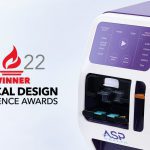



Events of the last two years have thrown a spotlight on diagnostics, with the industry evolving rapidly on the back of the pandemic.
At the recent 2022 AACC Annual Scientific Meeting & Clinical Lab Expo in Chicago, Illinois, I moderated an insightful panel with three industry experts: John Hart, President and CEO of ASP Health; Jay Srinivasan, Chief Strategy Officer at Truvian Sciences and Stuart Elliott, CEO and co-founder of Planet Innovation.
Speaking to a room beyond full capacity of attendees, they shared these exclusive insights as we explored the following topics:
How has the pandemic changed the diagnostics industry?
John: Firstly, the pandemic taught us that a country can shut down and also that your business can be shut down – therefore, supply chains can be disrupted. Perhaps in the past, we’ve become complacent with our supply chain thinking. Now, we need to make sure that we have alternatives for any potential disruptive situation.
Stuart: I think for those of us who are engineers, we’ve been trained in ‘just in time’ manufacturing – I think now, that’s been replaced by ‘just in case’ manufacturing. The idea of having a supply chain delivering the minimum amount of inventory doesn’t actually work anymore. There are flow-on implications from that such as the uncertainty of supply and demand – two of the biggest implications are the amount of working capital needed throughout the supply chain; and the concept of single source manufacturing. Single source manufacturing is not actually a brilliant idea. Having a single supply stream, in a single geography is a pretty high-risk strategy. As a manufacturer, we’re seeing our customers really interested in dual-source manufacturing and dual-supply/dual-geography for manufacturing. So, if there’s a problem in one country, you can supply the rest of the world out of another geography.
Jay: One thing that has radically changed is the fast pace of innovation. We’re an industry that is assumed to do some really innovative stuff, but the pace of innovation has always been suspect within our industry. But that’s really picked up now. The EUA approvals created some great opportunities for early-stage companies and created new commercialization models for some mid-size companies. The pandemic really asked every kind of company, big or small, to rethink how they would not only build products for their customers and consumers; but how they build products for their own internal staff.
John: For companies currently in the regulatory cycle, the pandemic enabled us to witness Emergency Use Authorization and we saw that the FDA can move a lot faster than it typically has before. We’re all going to put pressure on the FDA to review new technologies in diagnostics now, because we need to be at the forefront.
Anthony: To me, it seems as though new customer settings for people to receive a diagnostic test – whether it’s a drive-through or a Walgreens – tests can be purchased over the counter and the ability to access diagnostics seems greater than what it was back in 2020.
What forces will shape the next wave of innovation in diagnostics?
Jay: I think consumerization of healthcare – one of the big services we can do as an industry is to be really able to bridge between a laboratory to an eventual patient and/or consumer. Technologies are important and there’s a gamut of them we could talk about – robots, artificial intelligence, 5G and so on – but the thing about healthcare is that because it’s interconnected, everything we do is tied to some sort of provider-patient-payer model (or some variant of that), it’s important that everything we do is tied to building products that are inherently built into the ecosystem and don’t stand out.
Stuart: We’re an innovation company and I’m a great believer in innovation being driven by market-pull rather than technology-push. What’s really exciting at this point in time though is the market in diagnostics has changed radically. Everyone knows about diagnostics now – your next-door neighbour, your Uber driver – they all know what a PCR test is. Government ministers and politicians around the world know about diagnostics beyond the meaning of PCR and RAT – they know what the sensitivity and specificity are and that is completely changing the market dynamic, for a whole range of things. I firmly believe the next wave of innovation is not going to be driven by some game-changing, breakthrough technology but rather, better adaptation of technologies that already exist. Healthcare is driven by governments, and now, people in those governments that previously didn’t even know about diagnostics are very cognizant of it – which I think is going to drive a lot of opportunity for innovation and change.
John: I think telemedicine. We’ve all just experienced two years’ worth of a lot of progress in this area which has changed the paradigm; we aren’t going to go back now. Secondly, I think we are still in the midst of the incredible innovation that the human genome project launched for us. There is so much activity with next-generation sequencing, especially in cancer diagnostics – I expect that to continue.
Stuart: I think the cost aspect is going to be one of the key drivers of innovation in diagnostics, not just a consequence. During the pandemic we saw government – quite rightly – investing heavily in diagnostics. Now, they want to rein that spending in. The healthcare of citizens is important; but there’s a pandemic response, and then there’s sustainable investment – and they are two very different numbers. So, I think that’s actually going to be driving a lot of innovation – how do we reduce not just the cost per test but also the cost of healthcare.
Jay: This is our credo at Truvian. We believe our mission supports accessibility and affordability in healthcare…but healthcare itself must be viewed as a foundational human right. I feel that most parts of the world as we’ve talked about are disadvantaged and therefore products that we build as an industry must always try to be accessible and affordable. This is key because it will eventually drive adoption for the industry obviously but also grow kind of the relevance of diagnostics.
What can companies do to position themselves as winners in a changing diagnostics landscape?
John: I think winning still looks the same – it’s passion, following your mission and intense focus, getting to feel the technology, the market, building a robust portfolio through internal development and acquisition. In my previous role at Baxter, we were in the IV business and had a great plastic bag manufacturing business. We translated that product into the respiratory therapy business, the renal therapy business, the blood collection business to name a few. We did this through technology-focus and having strong cross-functional teams who can look at things from different perspectives.
Jay: Firstly, the pandemic has reinforced that the need to be agile is paramount. Now, we are all truly borderless in many ways as we compete, but therefore while we may have an international presence, not every company has the mindset of being an international company. Also, when it comes to ‘winning’ even as a diagnostics company, it’s still all about experience. It doesn’t matter what we build and sell to customers, consumers or patients…it’s the experience we leave them with, that counts.
Stuart: One word, digital. We see huge opportunities for the collection and management of data and solving problems in a clever way and using digital as an enabler for that. What we see are the companies that are digital native are ‘winning’ at a greater rate than those who are not. An example in the consumer industry is Uber versus taxi. If you approach your product as a piece of hardware and then get to the end and wonder ‘how am I going to bolt on a digital platform’, on the back end of that, well that’s going to be a taxi. If you approach it as a digital native organization and think, how do I add the most value for the end-user, not just the consumer but all the stakeholders in the healthcare industry.
John: During my time as head of product development at Baxter, I studied where the product development ideas came from – and they never came from the formal product development process. They came from somebody listening to a customer, or providing answers to customer questions, or from an individual in a cross-functional team looking at something differently.
Stuart: What we see when that happens is that it opens up new opportunities to provide value-add products and value-add services and not just an app on the back end. When you combine what we see with what’s happened in the last two years, like we have in point-of-care diagnostics, then the obvious opportunity is for consumers to drive that and say they want control of their own data. They want to control their own diagnostics. That’s the key driver I see is the digital first companies are going to win.
Final thoughts:
John: I think the regulatory agencies that partner and work with our industry will determine which countries advance the fastest. In the last five years, we’ve had conversations with the FDA that I never could have imagined thirty years ago. The combination of CMS, working with FDA and getting reimbursement approval in parallel with regulatory approval is really phenomenal. Regulatory agencies need to play a role in the country’s advancement; they can be a real limiter, or they can be very helpful.
Jay: When it comes to solving problems that are strictly around performance, around sensitivity and specificity, I think the ability to accelerate knowledge generation and pattern-matching will really lend itself to technologies like quantum computing. Interconnectivity with the cloud is going to be very critical. As an industry, we need to work through this process of data leaving the boundaries of care and then our industry will evolve.
Stuart: I think the real breakthroughs are going to be in order of magnitude cost reduction for technologies that already exist. That’s what we are seeing in other industries, and I think that’s what will drive the big change in diagnostics – not necessarily a breakthrough technology that none of us have heard of.
PI offers the full spectrum of product development and manufacturing capabilities needed to create and commercialize sophisticated, connected products. We can help you with any or all of your needs – from identifying a market opportunity, through design, engineering and digital, to manufacture and commercial launch. Our flexible approach and ability to scale support means we can tailor our services to suit your needs
Let’s talk